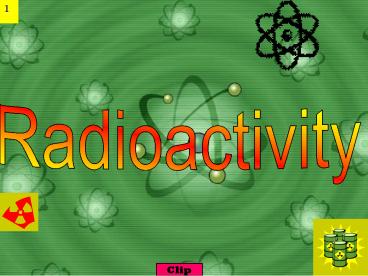Radioactivity - PowerPoint PPT Presentation
1 / 13
Title: Radioactivity
1
1
Radioactivity
Clip
2
3
Radioactivity is the spontaneous disintegration
of atomic nuclei. The nucleus emits a particles,
ß particles, or electromagnetic rays during this
process.
After decaying, radioactive atoms change into
other atoms
Clip
3
4
- Why does the atom do this?
- the nucleus of an atom attempts to become more
stable - In some instances, a new element is formed and in
other cases, a new form of the original element,
called an isotope, appears. - this process of change is often referred to as
the decay of atoms. - The rate of Radioactive decay is described in
half-lives.
4
- Energy is released during radioactive decay
5
5
Types of Nuclear Radiation
6
- When an unstable nucleus decays, particles and
energy are given off from the decaying nucleus. - a and ß radiation is in the form of particles
- ? radiation is in the form of waves-kind of like
light but higher frequency
6
7
Nuclear Decay
2 protons 2 neutrons
Neutron decays into a proton
7
13
8
14
- Biological Effects of Radiation
- Ionizing radiation causes physical damage to
cells and DNA. - Radiation can excite DNA and result in the
destruction on the DNA backbone. - At high doses of radiation (10,000 - 15,000
rads), death occurs in a few hours because of
neurological and cardiovascular breakdown
(Central Nervous Syndrome).
9
14
- Biological Effects of Radiation
- Medium doses, 500 - 1200 rads, causes death to
occur in a few days because of the destruction of
the gastrointestinal mucosa. - Lower doses, 250 - 500 rads, causes death to
occur after several weeks due to damage of the
blood forming organs (hematopoietic syndrome).
10
Fission and Fusion
18
Fission
Fusion
Splitting a nucleus
Combining of two nuclei.
11
19
- Nuclear power can come from the fission of
uranium, plutonium or thorium or the fusion of
hydrogen into helium. - Today it is almost all uranium.
- The fission of an atom of uranium produces 10
million times the energy produced by the
combustion of an atom of carbon from coal.
12
- Issues for Fission Power Plants
- Need for a spent fuel disposal facility and a
decommissioning plan - Use of large amounts of water for cooling
purposes (if wet cooling towers are used)
thermal pollution - Biological impacts on the ocean due to thermal
discharge (if seawater cooling is used) - Public safety concerns
20
Clip
13
- Half Life is the amount of time it takes
- for half of the nuclei in a sample to decay
22
Mass (kg)































